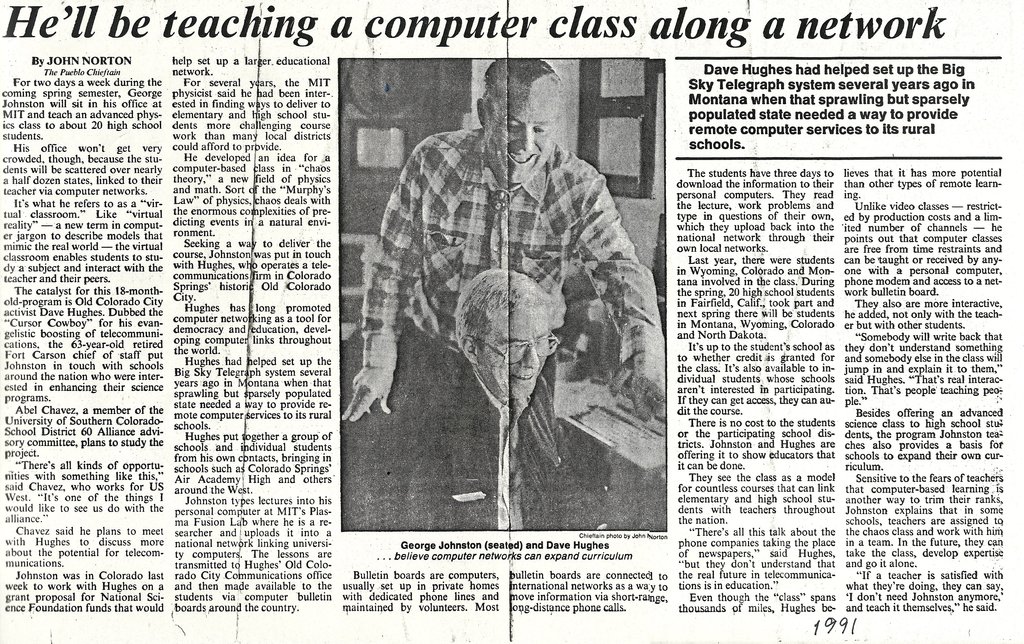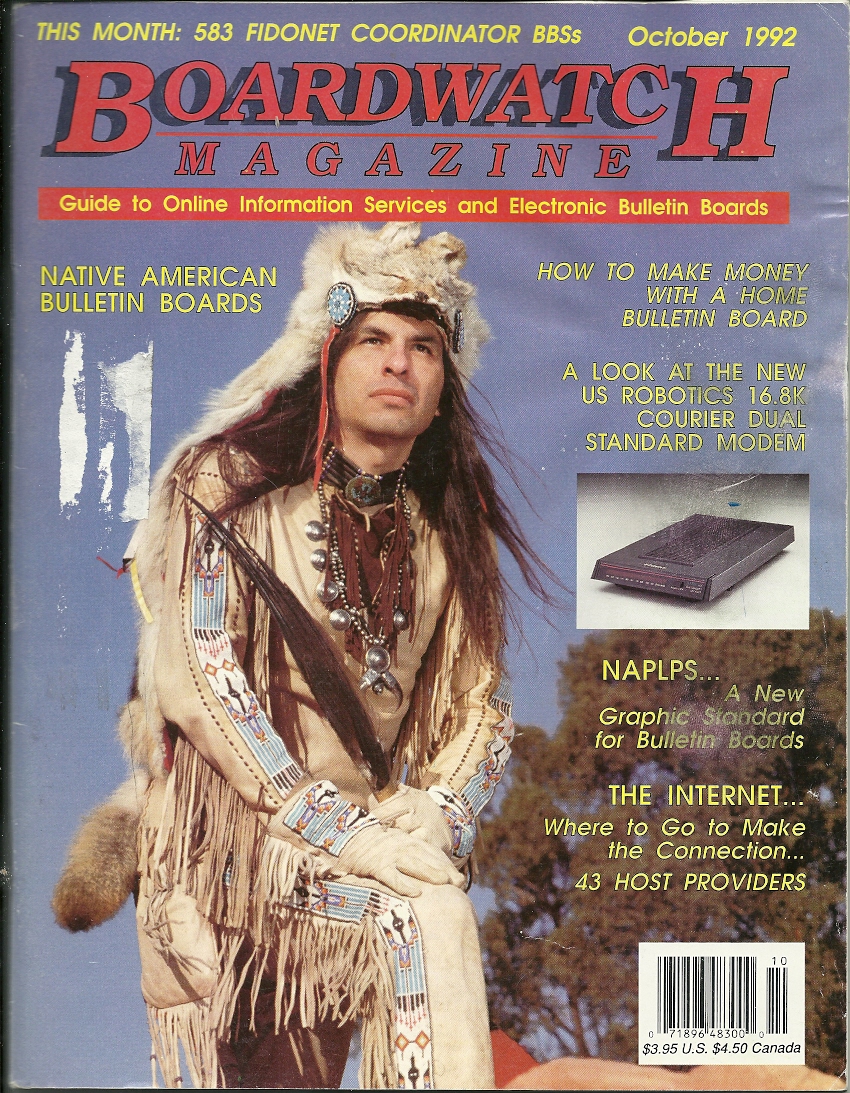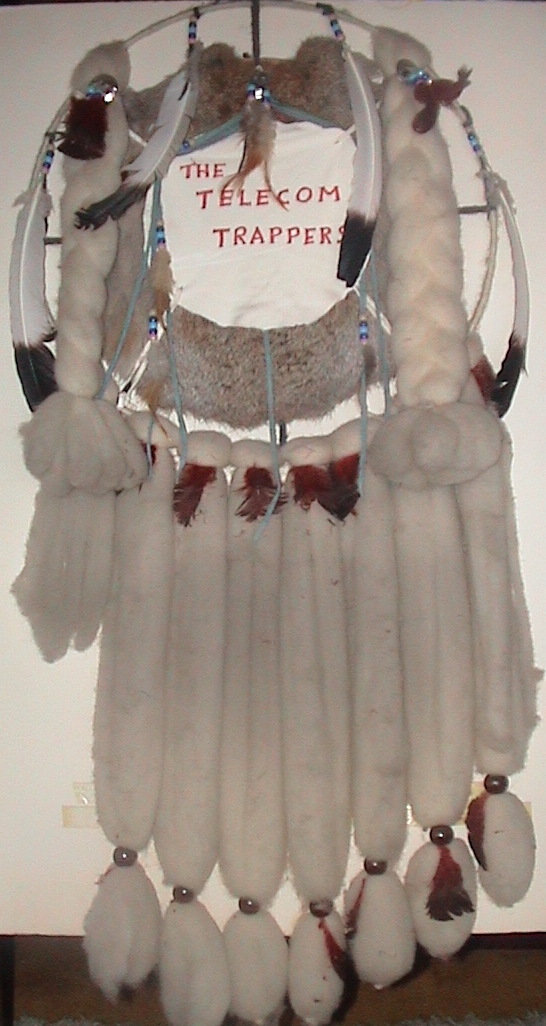From Student to Teacher Training
It became evident to me that, whatever young students could learn FROM as well as ABOUT advanced forms of computer networked education, it was the Teachers who needed educating themselves more than anyone. Whole new modes of teaching would have to be learned, as much by trial and error 'doing' as by being taught formally. Teacher's colleges, including Western Montana College were woefully behind the technical and pedagogical curve. Their Principals were usually worse off and had little basis for making sound management decisions about the types of technologies were needed. And school boards usually were clueless - except that whenever one school board member bought an Apple, or Radio Shack, or the newest IBM personal computer for business or saw them at a university - they would discover the power of personal computers connected by modems to national services and start prodding their School Administrators to answer the question why their District didn't have such computers, and were teaching them.
But just how far out on the educational frontier that even very low cost, personal computer and networking could push happened when I was contacted in 1991 by an MIT Physicist - Dr George Johnston. He had read about my telecom pioneering and, in concert with many MIT professors, was very concerned about the state of American education - particularly in math the sciences. He wanted to know whether I could - with my telecommunications skills - help him teach both bright students and even some of their teachers - distant from the Boston area. That some of the MIT faculty visited only schools in the local area on occassion, but never students far away.
He suggest teaching an online Course in the Theory and Math of Chaos!

Chaos Online
THAT was as about frontier science as one could want.
Since at that time I was already supporting the Fido Network Big Sky Telegraph Project in Montana I knew we could incorporate a few Montana, maybe even Wyoming schools into a course with some Colorado Springs Schools and teachers.
George, of course would have the task of teaching the actual course in Chaos, while I would have to teach him, AND the teachers, as well as the students in networking skills. I even had developed a formal course which Colorado Technical College had asked me to do called 'Electronic English' which I used to get everyone online in the 'connected classroom' to understand the online culture.
Dr Johnston and I started when I supported his teaching about 8 students over the Internet to a local westside Junior High School class whose Math teacher had gotten his Master's degree AFTER the science of Chaos was even known. So he took the course right along with his students! By the time they all were looking at the beautiful Fractals generated by their own computers after the Chaos math code came in over the modem line, they were hooked, not only with the science, but with this mode of learning online.
My forecast that online delivered and supported education was going to cause a Revolution in K-12 education across the country was beginning to be realized.
I then set up a multi-centered Fido+Internet network that linked a whole class of advance placement students at Air Force Academy high school, two students in advanced studies at Cody High School, Cody, Wyoming and one bright student at a one room school in Guildford, far northern Montana which was connected by their Fido Bulletin Board system.
Dr Johnson quickly learned that half of his problem teaching the class, was the radically different methods needed to keep 'classroom discipline' online instead of in face to face classroom settings. And that students - to take an online course had to be far more proactive than they could get away with being passive in a classroom setting. Bright high school boy students would flirt with the girls far away from their school over side messages. But the course proceeded and a bona fide course in Chaos was taught and something was learned everywhere.
The most noteworthy thing that happened was that a girl in her high school in Cody, Wyoming - which was not even able to offer her AP Calculus locally - wanted to go to a really advanced college. Dr Johnston suggested she try MIT. He worked with her in the Chaos course, saw how very bright she was, and to his delight - and hers - she applied and matriculated at MIT the next year. And he had never seen or talked to her face to face while all that happened.
Later Dr Johnston authored an article in a national Educational Journal. And Dr Johnston, Plasma Physicist at MIT presented a paper to the Federal Coordinating Council on Science, Engineering and Technology in which he lavishly credited me with developing the technologies that made advanced science education to any place or school in the nation. And made specific recommendations about how the Federal Government should support the development all across the country in 'distance learning.'
Plain Math Class - For Teachers
For the next academic year, we tried something else. Colorado Springs Teachers, having heard about the Chaos course, were very interested in taking a math class from the MIT Physicist but only if they could get credits toward a degree. And Johnson knew that even more fundamental math skills were needed by teachers he had met.
We managed to get that done - the State of Colorado certified Dr. Johnston's obvious credentials, School District 11 identified the Doherty High School as one where a number of math teachers wanted to take a course that simply advanced their knowledge of math - not as far as scientific Chaos, but beyond what they were used to. That worked, - he taught them from Cambridge entirely online. He flew out to Colorado Springs for the first and last class, meeting them face to face one time and awarded them their grades and credits for college post graduate degrees.
By this time Frank Odasz was doing, and championing Online Education in many ways no longer needing me. He had the vision, was mastering the technology, and the new methods of instruction, and so pursued opportunities to educate educators. In fact when he left Western Montana College he started up Lone Eagle Consulting - which he has pursued from Latin America to Northern Alaska over the past 25 years.
In his own words he described what he called the National and Global Impacts of Big Sky Telegraph
"Over time it became clearer that the biggest impacts of the BST project were not on those who participated directly, but were on those in other states and countries who read the colorful stories written by Dave Hughes on the pioneering teachers in remote one-room schools sharing curriculum online and beginning to communicate with educators globally. Many people became inspired that “if they can do it in rural Montana, why can’t we do this in our state?” Larger than life stories created major motivation for grassroots champions in other states to imagine what’s possible and to generate dozens of projects that ultimately went beyond the scope and scale of the Big Sky Telegraph.
As there were few rural online learning projects during the late 1980s and early 1990’s, I enjoyed being a frequent presenter at national educational technology community networking conferences. Online learning and collaboration naturally supported building both virtual and geographical communities. Some weeks I’d fly coast to coast twice. From 1988 to 1998 I averaged roughly 50,000 miles a year."
Native American Share Art
While I was repeatedly visiting Montana, driving to and from Colorado, I knew I was also entering Indian territories. Sioux, Crow, Assiniboine, who, both on their reservations and in other places had the typical native American tribal problems of very low incomes and poor education for their children.
But many of them had tribal art - in many forms. I conceived of the idea of 'Share Art' delivered over telecom.

There already was the growth of what was called 'shareware' - computer programs that were good and useful, but not fully commercialized. The idea was that you could download or get a copy of a useful program, and 'share it' with its author by sending him what he thinks its worth.
Why not encourage Native Americans with artistic talent or aspirations to create pieces in the Naplps software format, and distribute it rapidly online - not waiting for galleries to accept them - asking for some form of payment?
So in Billings, Montana, close to the Crow Reservation we invited about 10 artists to come to a Naplps-Computer-Network Share Art session. In a one day session, with numerous computers for them to work on - and even, across the room - exchange their work, several Indians got the idea.
It got off the ground to the point the Sioux Tribe of South Dakota invited me to come there and teach them too. Which I did. But not before my car was damaged by a ferocious hailstorm as I was driving across Wyoming to see them. One of their Chiefs told me that the Great Spirit had punished me for teaching the Crow - their traditional enemies - before I taught them - the Sioux.
A number of artists got to work in the new 'medium' distributed their work over modems from their reservations, and received payments.
Below is an Article Cynthia Denton, Educator from Hobson, Montana, whom I trained in the Telecom and even NAPLPS arts. She even set up her own BBS and wrote it for the Silicon Valley Software Review. It even describes how I was able to take an old Assiniboine Tribal tale and render it in both English and Assiniboine, dynamically. As a way for very young Assiniboine school children could learn, simultaneously their own language and English.
It is a PDF file. Just click on it. (The very last paragraph got truncated slightly)
Share-art by Indians lasted until Naplps was superseded by the World Wide Web and its graphics. By then many Native American artists knew enough to be able to adapt to later technologies.
Once again I, with willing partners like Frank Odasz, had pioneered methods that later became mainstream and commercialized.
Telecom Trappers Rendezvous
Frank Odasz explained in one posting:
"The era of the first white trappers lasted only twenty years before the settlers followed them and ended their era. Dave and I decided to hold a special conference in Cody, Wyoming to recognize the passing nature of the era of the early online pioneers.
Our goal for the rendezvous was to acknowledge and celebrate our awareness of the brief nature of the era of the first explorations on this new frontier, knowing that the pristine online landscapes would soon change forever as the dust clouds of the advancing settlers were already on the horizon.
Twenty-five persons attended coming from both coasts and we sat in a Rocky Mountain meadow of wildflowers on a spring day with a microcomputer at the end of a couple hundred feet of extension cords to view some of the first Native American digital Share-art in history and to talk about themes such as “with power comes responsibility” and how online communication was unlocking profound potential for global education, community empowerment, cultural sovereignty, and more, much more.
It was this visioning that was special to our group and we intuitively knew the future would be limited only by our imaginations."
It was during that Rendezvous and after everyone except Frank and I had left Cody, that I carried a laptop computer with me on my horse. Having grown up with horses and very comfortable with them, especially western style saddles and riding, I even started an innovation that got me lots of California publicity as the 'Cursor Cowboy'
I set out to buy the frame of a western saddle, and started putting keyboard keys to the right and left of the pommel horn, then insert an LCD sized screen in the saddle horn, and then put the body of the computer in one saddle bag, and an amateur digital radio with batteries in the other saddle bag.
So I could connect up to the world from atop my horse!
While I soon got sidetracked pursuing some digital wireless answer, I never finished the saddle.
But the idea of a lone cowboy riding the range - connected stimulated my muse, which I exercised out loud by talking to myself or singing, while I was driving those long dull stretches across Wyoming on the way to Dillon and back. Here is one result, which I also rendered in a dynamic animation in Naplps graphics.
Cursor Cowboy's Song
Oh I got a little cabin in the Rockies
A pickup truck, my boots, and a PC Clone
The calves are new, the bills are due, and my woman's left me.
But I never am alone, when I hear that modem tone.
For you never are alone when you hear that modem tone,
Just keep loggo'n on, just keep logg'on on.
The Demise of Big Sky Telegraph
Originally, the Big Sky Telegraph offered dial-up Internet access for only $10/month, but now local Internet services were becoming available. They were certainly more affordable than long distance calls to BST, offering unlimited local access for a flat fee. This new option caused people to leave the collaborative Big Sky Telegraph to become solo-basement browsers. When the IRS announced that institutions of higher education could no longer charge for providing dial-up Internet access the economic sustainability the Big Sky Telegraph disappeared and US West ended their funding support.
But valuable lessons had been learned by educators and administrators. Frank Odaz pioneered for himself in the most remote native villages of Alaska thereafter.
One could say, Frank Odaz became a disciple of mine. He made a career of what we started with Big Sky, motivating schools, teachers, grant funding sources, including Federal. He has written a long and accurate account of his educational activities and initiatives, also discussing my involvement. It is a pdf file you can click on the blued word odazhist below.
The best summary of ALL I have done from my first BBS, through the Source, and Big Sky Telegraph came from the 1993 book by Howard Rheingold called "The Virtual Community" Typical of the California, Silicon Valley up tightedness about a two-war West Point graduate, now a retired Colonel, some of the comments are left handed compliments. But read it and it pretty much sums up my vision and methods. It amused me that I was teaching the counter-culture anti-war hacker generation how to use the technologies they invented. But as I always maintained, engineers know 'how' but I know 'why.'
Click on this PDF link Virtual Community
But Need for Better Bandwidth
Meanwhile I fretted from the limitations of the availability and reach of data lines. Telephone Modems were fine as far as they went but even theoretically they could not do more than 56kbps - the bandwidth of the human voice.
I knew that telephone company data lines could handle what was called T-1 speeds - 1.544 megabits per second- but were very expensive for anyone not part of a company, large urban school system, or government itself. And just laying a T-1 data line by the Telephone Company was barely affordable by institutions, and hardly ever by individuals at home much less remote rural ranches or farms.
I started looking around for wireless solutions.
I found it with Hedy Lamar and Frequency Hopping. Which opened up a whole new chapter in my Telecom life.
Go onto the National Science Foundation Saga

